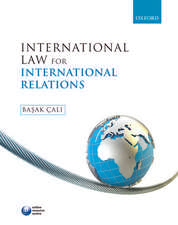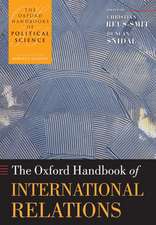The Theoretical and Practical Dimensions of Regionalism in East Asia
Autor Karolina Klecha-Tylecen Limba Engleză Hardback – 15 dec 2016
| Toate formatele și edițiile | Preț | Express |
|---|---|---|
| Paperback (1) | 782.87 lei 43-57 zile | |
| Springer International Publishing – 3 iul 2018 | 782.87 lei 43-57 zile | |
| Hardback (1) | 795.02 lei 43-57 zile | |
| Springer International Publishing – 15 dec 2016 | 795.02 lei 43-57 zile |
Preț: 795.02 lei
Preț vechi: 969.53 lei
-18% Nou
Puncte Express: 1193
Preț estimativ în valută:
152.12€ • 159.26$ • 125.87£
152.12€ • 159.26$ • 125.87£
Carte tipărită la comandă
Livrare economică 07-21 aprilie
Preluare comenzi: 021 569.72.76
Specificații
ISBN-13: 9783319402611
ISBN-10: 3319402617
Pagini: 357
Ilustrații: XVIII, 372 p. 24 illus. in color.
Dimensiuni: 148 x 210 x 25 mm
Greutate: 0.82 kg
Ediția:1st ed. 2017
Editura: Springer International Publishing
Colecția Palgrave Macmillan
Locul publicării:Cham, Switzerland
ISBN-10: 3319402617
Pagini: 357
Ilustrații: XVIII, 372 p. 24 illus. in color.
Dimensiuni: 148 x 210 x 25 mm
Greutate: 0.82 kg
Ediția:1st ed. 2017
Editura: Springer International Publishing
Colecția Palgrave Macmillan
Locul publicării:Cham, Switzerland
Cuprins
1. Introduction
2. Regionalism and Regionalisation - A Theoretical Approach
2.1 Regionalism and regionalisation in the theory of social sciences
2.2 Old vs. new regionalism - a comparative analysis
2.3 Regionalism and regionalisation in the context of globalization
2.4 The types of regionalism - a review
2.5 Regionalism vs. multilateralism, interregionalism and regionalisation
2.6 The selected methods for measuring the phenomena of regionalism and regionalisation
3. Regionalism and Regionalisation in East Asia - Their Essence, Origin and Transformations
3.1 East Asia - characteristics of the region and its subregions
3.2 The concept, reasons for and characteristics of East Asian regionalism
3.3 The stages and drivers of developing regionalism in East Asia
3.4 East Asia's regionalisation - the network and territorial dimension of regional processes
3.5 The geospatial dimension of East Asian regionalism - the levels and structure of the process
4. The Microregional and Subregional Dimension of East Asian Regionalism
4.1 The subnational dimension of regionalism in East Asia
4.2 The transnational dimension of regionalism in East Asia
4.3 Hybrid subregional cooperation programmes in East Asia
4.4 The transnational dimension of East Asian subregional cooperation
4.5 Cooperation within the framework of East Asia's southern subregion - the Association of Southeast Asian Nations
5. East Asian regionalism - The Macroregional Dimensions of Relations
5.1 The evolution of cooperation within the framework of ASEAN Plus Three and East Asian ASEAN Plus One summits
5.2 The origins and development of the East Asia Summit
6. East Asian Regionalism - An Empirical Analysis
6.1 A review of selected research studies on East Asian regionalism
6.2 Gravity models - a tool for assessing regionalism processes
6.3 An empirical research of the impact of East Asian regionalism on trade exchange
6.3.1 The analysis of correlation coefficients between foreign trade volumes and their determinants (dynamic approach)
6.3.2 The classification of explanatory variables based on Ward's method
6.3.3 The characteristics of the adopted statistical methods
6.3.4 A comparative analysis of the degree of adjusting the regression function to empirical data
6.3.5 An analysis of correlations between explanatory variables and the dependent variable
6.3.6 The results of estimations in a general approach.
6.3.7 The results of estimations by groups of countries
6.3.8 Estimation results in a time-based approach
6.3.9 Summary of research results
7. Concluding Remarks
Notă biografică
Karolina Klecha-Tylec is Assistant Professor of International Economics at Cracow University of Economics, Poland. She specializes in economic integration processes, the regionalism and regionalisation of the world economy, and economic development strategies with a particular focus on East Asia.
Textul de pe ultima copertă
This book provides a comprehensive overview of developments in East Asian regionalism, combining qualitative evidence with empirical quantitative analysis. It argues that two dominant processes have formed East Asian regionalism: regionalization on the one hand, and inter-regionalism on the other. Klecha-Tylec examines the differences between traditional and new regionalisms as they apply to East Asia; the differences between East Asian and European regionalism; the role of the United States in shaping regional links; and the evolution of the three key structures of ASEAN, ASEAN+3, and Asia Summits. The analysis she provides is unique for examining together the network, zonal, and geospatial dimensions of relations in East Asia as they apply at micro-regional, sub-regional, macro-regional, trans-regional and inter-regional levels. The book thus offers a detailed analysis of intra-regional links and the hybrid relationships between micro-regions and nation-states.
Caracteristici
Provides one of the most comprehensive overviews to date of the development of East Asian regionalism
Considers multilateral, inter-regional, and trans-regional relationships
Offers a novel quantitative analysis of trade determinants
Considers multilateral, inter-regional, and trans-regional relationships
Offers a novel quantitative analysis of trade determinants















